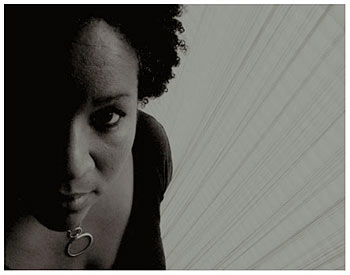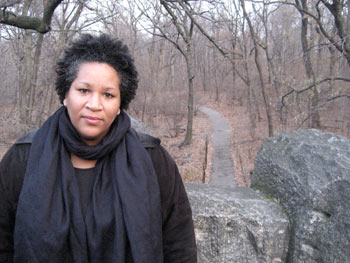A Goddess At The Console: Q&A With Mary Edwards
Published on January 30th, 2011 in: All You Need Is Now, Current Faves, Feminism, Issues, Music, Q&A |By John Lane
In another era, Mary Edwards might have been a behind-the-scenes songwriter in the famous Brill Building, that renowned stable of musical artisans that included Goffin & King, Laura Nyro, and a host of others. Instead, in this era, we are lucky to have singer/songwriter Mary Edwards in clear view. Her music is characterized by a smooth charm that draws upon soft-pop, jazz, and funk, framed with a soulful voice that is reminiscent of Dionne Warwick in her prime; her attitude reflects an almost guileless enthrallment with music and the sometimes subtle, gifted influences that can become songwriting fodder. I caught up with Mary upon the recent release of her latest album, Console.
Popshifter: Mary, so it’s a new year and new album with Console! To your mind, what separates this album from its predecessor, A Smile In The Mind (2007)? There’s definitely a different feel here, perhaps a more refined groove.

Mary Edwards: Happy New Year, and yes, it’s nice to have a new album! I was going for a wider range of influences outside of my ’60s Pop Contempo comfort zone. It was time to move up the proverbial timeline—as I was now creatively existing in a parallel universe of 1979/1980—and introduce the essence of some other artists that colored my youth: Steely Dan, Nile Rogers, Rod Temperton, Chicago, Laura Nyro, and Brian Auger. The Hammond was my first instrument and I could only imagine how much more fluid and warm it could sound if I only had the dexterity of Brian Auger! I aspired to creating more rhythms and less Loungecore.
The lyrics are perhaps more mature, because I’m comfortably straddling a reflective and present state. The narrative has shifted from a stunned inquiry of “What happened?” to rather feeling an appreciative “Thank you.” I’ve become a little more adventurous in instrumentation. Both the opener and the title track offer an ethereal, Prog-rock feel. My recording production methods are reflective of my visual arts background. A Smile In The Mind was an architectural process, in that I was “constructing” and “restoring” a sound; Console was more of a painterly approach, with gradient swatches of mood and color. I sense that the next album will be sculptural in nature—molding, shaping, contouring.
Popshifter: If you don’t mind, let’s have a word about what characterizes many of your songs. The standout new track “Bouleversant” epitomizes that unique balance of a Mary Edwards tune; its Bacharach-esque horn arrangement is matched with the melancholy words, “I’ve been haunted by the fragments.” I’m a big fan of music that manages to affix happy and sad together and meets somewhere in the middle. Is this a conscious move on your part?
Mary Edwards: It is. “Bouleversant” was originally written in a Bacharachian 3/4 signature, uplifting in tempo, but conveying an honest reluctance in the lyric. The 4/4 signature version on the album delivers the same driving conviction of the chorus and instrumental bridge, but this time with a horn arrangement inspired by that of Bill Conti’s “Rocky‘s Theme,” to represent that surprising strength that the said fragments hold when you reconstruct what’s left over from the thing that falls apart. When I look back—sometimes recoiling in horror at my naïveté—at lyrics I wrote in my early 20s, I was ridiculously idealistic about love and other interpersonal relations.
As I approached 40, I was delighted by the empowerment that comes from shifting one’s expectations without lowering the bar. You have the ability to keep some things and reframe them, and you have the power to release what doesn’t serve you. Do these things without spite or contempt, and with just enough vulnerability, and you have experienced absolute freedom.
Popshifter: Switching gears, you also have an atypical Mary Edwards tune, “The Sound of Someday,” with a title that is just such a wonderful throwback (I wish I’d thought of it, damn it!). Around the 3:38 mark, there’s a sumptuous interplay between horns and electric piano (the latter being very subtle and soft). How long does it take you to sort of “figure out” how these little interplays will go? Is it something you have already assiduously demoed or do you make the discovery as you’re working it out in the studio?
Mary Edwards: I hear most everything in my head, then spend time sorting it all out on paper and instrumentally. Since it’s mostly just me in the studio, I’m assuming one role at a time; however, the roles often overlap, and it’s like having multiple personalities—my “engineer” is talking to my “backing vocalist” who is sharing a laugh with the “cellist.” It’s all kind of abstracted and twisted in there, like Alice in Wonderland without the mushrooms and rabbit holes—expansions and contractions and stretches of the imagination until the right sound comes to fruition. There’s a method to the madness, and it’s ultimately all very straightaway and tidy by the end of the session.
That interplay of the horns and Rhodes you hear was quite organic. The vocal layering that precedes it took a great deal of effort, in order to corral all that resonance and have each voice represent the past, present, and future. The song is an amalgamation of memories, mostly of how I imagined my adult life would be. Something in my mother’s voice carried that mellifluous assuredness that “someday” would be a rich, cinematic imagery. The last time I performed that song live, I got choked up when I tried to sing the “million dollar movie” line to my brother Jonathan who was in the audience. We are very close, and he—as well as my other siblings, parents, and partner—pleasantly color the way I experience things.

Popshifter: This is a good a place as any to discuss your roots. You’re an unrepentant champion and citizen of your hometown Staten Island (a place that gets unfairly maligned, like my hometown of Baltimore). It gets special mention in your song “White Jumpsuit” from your previous album. How much of Staten Island informs your work as an influence?
Mary Edwards: Staten Island still has a pastoral soulfulness that is complemented by the resplendent light of Manhattan and the cozy chic-ness of Brooklyn. It’s often misunderstood because it’s seen as one big neighborhood with an anomalous undertone, and not by the nuances that make up the whole.
“White Jumpsuit” is a three-minute “movie” about a ten-year-old girl in New York who aspires, if only she were another decade older, to be an L.A. session singer for all the Southern California artists she hears on Top 40 Radio. Staten Island, in her mind, goes from being a sore point to a touchstone of pride, as she realizes many well-known recording artists came right from her own hometown, and that she could be one, too.
The Island has an influence on other facets of my music; I also compose about and for space. Growing up, I had a wildly peripatetic sense of being and imagination which was fed by both all the untouched forest and the newly constructed modernist buildings that seemed to enrich the landscape like otherworldly, intelligent beings that landed out of nowhere. I embraced the dichotomy of the built and the un-built, and it, in turn, translated to how I thought about music composition. I’ve since returned to pursue a grant opportunity to do an environmental sound installation for the Greenbelt/High Rock Nature Conservancy.
Pages: 1 2
3 Responses to “A Goddess At The Console: Q&A With Mary Edwards”
January 31st, 2011 at 4:56 am
Great interview. ME is a vibrant and very relevant artist. She has always has something important and interesting to say. Her sophomore epos is such a seminal album, and I can’t wait to see where she takes us next!
January 31st, 2011 at 10:53 am
Fascinating stuff…Mary’s music is so organic to and integrated with who she is that the flow between them feels seamless, invisible. I imagine everything she feels, thinks, eats, sees – both past and present – inform her songmaking. And both she and they are beautiful.
January 31st, 2011 at 3:16 pm
So glad to get caught up on your good work Mary! In Staten Island, no less (I always thought you were a Brooklyn girl)
Time limit is exhausted. Please reload the CAPTCHA.